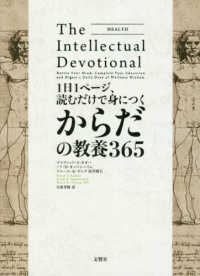- ホーム
- > 洋書
- > ドイツ書
- > Mathematics, Sciences & Technology
- > Physics and Astronomy
- > mechanics & acoustics
Full Description
I had great pleasure in reading Philippe Refregier's book on the theory of noise and its applications in physics. The main aim of the book is to present the basic ideas used to characterize these unwanted random signals that obscure information content. To this end, the author devotes a sigificant part of his book to a detailed study of the probabilistic foundations of fluctuation theory. Following a concise and accurate account of the basics of probability the ory, the author includes a detailed study of stochastic processes, emphasizing the idea of the correlation function, which plays a key role in many areas of physics. Physicists often assume that the noise perturbing a signal is Gaussian. This hypothesis is justified if one can consider that the noise results from the superposition of a great many independent random perturbations. It is this fact that brings the author to discuss the theory underlying the addition of random variables, accompanied by a wide range of illustrative examples. Since noise affects information, the author is naturally led to consider Shannon's information theory, which in turn brings him to the altogether fundamental idea of entropy. This chapter is completed with a study of com plexity according to Kolmogorov. This idea is not commonly discussed in physics and the reader will certainly appreciate the clear presentation within these pages.
Contents
1 Introduction.- 2 Random Variables.- 2.1 Random Events and Probability.- 2.2 Random Variables.- 2.3 Means and Moments.- 2.4 Median and Mode of a Probability Distribution.- 2.5 Joint Random Variables.- 2.6 Covariance.- 2.7 Change of Variables.- 2.8 Stochastic Vectors.- Exercises.- 3 Fluctuations and Covariance.- 3.1 Stochastic Processes.- 3.2 Stationarity and Ergodicity.- 3.3 Ergodicity in Statistical Physics.- 3.4 Generalization to Stochastic Fields.- 3.5 Random Sequences and Cyclostationarity.- 3.6 Ergodic and Stationary Cases.- 3.7 Application to Optical Coherence.- 3.8 Fields and Partial Differential Equations.- 3.9 Power Spectral Density.- 3.10 Filters and Fluctuations.- 3.11 Application to Optical Imaging.- 3.12 Green Functions and Fluctuations.- 3.13 Stochastic Vector Fields.- 3.14 Application to the Polarization of Light.- 3.15 Ergodicity and Polarization of Light.- 3.16 Appendix: Wiener-Khinchine Theorem.- Exercises.- 4 Limit Theorems and Fluctuations.- 4.1 Sum of Random Variables.- 4.2 Characteristic Function.- 4.3 Central Limit Theorem.- 4.4 Gaussian Noise and Stable Probability Laws.- 4.5 A Simple Model of Speckle.- 4.6 Random Walks.- 4.7 Application to Diffusion.- 4.8 Random Walks and Space Dimensions.- 4.9 Rare Events and Particle Noise.- 4.10 Low Flux Speckle.- Exercises.- 5 Information and Fluctuations.- 5.1 Shannon Information.- 5.2 Entropy.- 5.3 Kolmogorov Complexity.- 5.4 Information and Stochastic Processes.- 5.5 Maximum Entropy Principle.- 5.6 Entropy of Continuous Distributions.- 5.7 Entropy, Propagation and Diffusion.- 5.8 Multidimensional Gaussian Case.- 5.9 Kullback-Leibler Measure.- 5.10 Appendix: Lagrange Multipliers.- Exercises.- 6 Thermodynamic Fluctuations.- 6.1 Gibbs Statistics.- 6.2 Free Energy.- 6.3 Connection with Thermodynamics.- 6.4Covariance of Fluctuations.- 6.5 A Simple Example.- 6.6 Fluctuation-Dissipation Theorem.- 6.7 Noise at the Terminals of an RC Circuit.- 6.8 Phase Transitions.- 6.9 Critical Fluctuations.- Exercises.- 7 Statistical Estimation.- 7.1 The Example of Poisson Noise.- 7.2 The Language of Statistics.- 7.3 Characterizing an Estimator.- 7.4 Maximum Likelihood Estimator.- 7.5 Cramer-Rao Bound in the Scalar Case.- 7.6 Exponential Family.- 7.7 Example Applications.- 7.8 Cramer-Rao Bound in the Vectorial Case.- 7.9 Likelihood and the Exponential Family.- 7.10 Examples in the Exponential Family.- 7.11 Robustness of Estimators.- 7.12 Appendix: Scalar Cramer-Rao Bound.- 7.13 Appendix: Efficient Statistics.- 7.14 Appendix: Vectorial Cramer-Rao Bound.- Exercises.- 8 Examples of Estimation in Physics.- 8.1 Measurement of Optical Flux.- 8.2 Measurement Accuracy in the Presence of Gaussian Noise.- 8.3 Estimating a Detection Efficiency.- 8.4 Estimating the Covariance Matrix.- 8.5 Application to Coherency Matrices.- 8.6 Making Estimates in the Presence of Speckle.- 8.7 Fluctuation-Dissipation and Estimation.- Exercises.- 9 Solutions to Exercises.- 9.1 Chapter Two. Random Variables.- 9.2 Chapter Three. Fluctuations and Covariance.- 9.3 Chapter Four. Limit Theorems and Fluctuations.- 9.4 Chapter Five. Information and Fluctuations.- 9.5 Chapter Six. Statistical Physics.- 9.6 Chapter Seven. Statistical Estimation.- 9.7 Chapter Eight. Examples of Estimation in Physics.- References.








